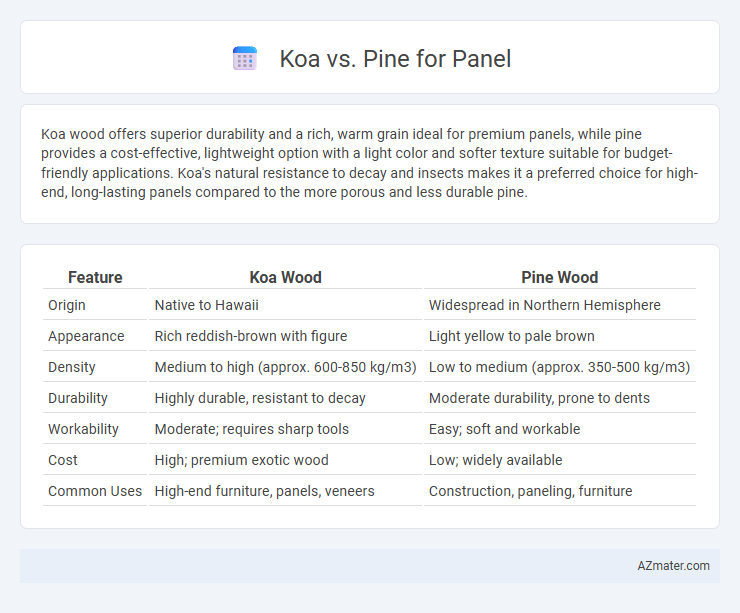Koa wood offers superior durability and a rich, warm grain ideal for premium panels, while pine provides a cost-effective, lightweight option with a light color and softer texture suitable for budget-friendly applications. Koa's natural resistance to decay and insects makes it a preferred choice for high-end, long-lasting panels compared to the more porous and less durable pine.
Table of Comparison
| Feature | Koa Wood | Pine Wood |
|---|---|---|
| Origin | Native to Hawaii | Widespread in Northern Hemisphere |
| Appearance | Rich reddish-brown with figure | Light yellow to pale brown |
| Density | Medium to high (approx. 600-850 kg/m3) | Low to medium (approx. 350-500 kg/m3) |
| Durability | Highly durable, resistant to decay | Moderate durability, prone to dents |
| Workability | Moderate; requires sharp tools | Easy; soft and workable |
| Cost | High; premium exotic wood | Low; widely available |
| Common Uses | High-end furniture, panels, veneers | Construction, paneling, furniture |
Introduction to Koa and Pine as Panel Woods
Koa, a prized hardwood native to Hawaii, is renowned for its rich reddish-brown hues and striking grain patterns, making it a premium choice for decorative panels. Pine, a softwood commonly sourced from various temperate regions, offers affordability and ease of working, featuring a lighter color with a more uniform grain suitable for versatile panel applications. Both woods provide unique aesthetic and structural qualities, with Koa delivering luxury and durability, while Pine emphasizes cost-effectiveness and adaptability in panel construction.
Botanical Overview: Koa vs Pine
Koa (Acacia koa) is a fast-growing hardwood native to Hawaii, characterized by its rich, curly grain and natural durability, making it highly prized for fine woodworking and musical instruments. Pine, belonging to the genus Pinus, is a softwood widely distributed across the Northern Hemisphere, known for its straight grain, light color, and ease of working with, often used in construction and furniture. Both species offer unique botanical features: Koa's dense, fine-textured wood contrasts with Pine's resinous, knotty timber, influencing their distinct aesthetic and functional uses in panel applications.
Appearance and Grain Patterns
Koa wood features a warm, golden to reddish-brown color with a highly figured grain pattern that often showcases curly or mottled effects, creating a striking visual appeal for panels. Pine offers a lighter, pale yellow to amber tone with a more uniform and straight grain, presenting a clean and classic appearance. Koa's intricate grain patterns make it a premium choice for decorative panels, while pine is favored for its simplicity and versatility in various interior designs.
Durability and Hardness Comparison
Koa wood exhibits a Janka hardness rating of approximately 1,820, making it notably durable and resistant to dents and wear, ideal for high-traffic panel applications. Pine, with a significantly lower Janka hardness around 380 to 870 depending on species, is softer and more prone to scratches and dents, reducing its longevity in similarly demanding panel uses. When prioritizing durability and hardness for paneling, Koa's dense grain structure and superior hardness provide a more robust and long-lasting surface compared to the softer and more vulnerable pine options.
Workability: Crafting with Koa vs Pine
Koa wood offers excellent workability with its fine, straight grain and smooth texture, making it ideal for detailed panel crafting and achieving a polished finish. Pine is softer and easier to shape but can be prone to dents and scratches, requiring careful handling during panel construction. Both woods respond well to staining and finishing, but Koa's stability reduces the risk of warping in panel applications.
Cost and Availability
Koa wood is generally more expensive than pine due to its limited availability and exotic status, making it a premium choice for premium panels. Pine is widely abundant and more affordable, offering cost-effective solutions for paneling projects without compromising basic durability. For budget-conscious projects prioritizing availability and lower expense, pine remains the preferred option, whereas koa suits high-end applications where cost is less of a constraint.
Environmental Impact and Sustainability
Koa and pine panels differ significantly in environmental impact and sustainability, with koa being a native Hawaiian hardwood known for its slower growth and higher carbon sequestration, enhancing forest ecosystem health. Pine, typically sourced from fast-growing plantations, offers quicker renewability but may involve intensive chemical use and monoculture practices that can reduce biodiversity. Choosing koa supports sustainable forestry with long-term ecological benefits, whereas pine provides a cost-effective option with a potentially larger environmental footprint due to less stringent harvesting standards.
Applications in Panel Making
Koa wood, known for its exceptional strength and rich grain patterns, is highly favored in luxury panel making for applications requiring durability and aesthetic appeal, such as custom wall panels and high-end furniture. Pine, being lighter and more cost-effective, is commonly used in interior paneling where ease of installation and affordability are priorities, including in residential wall panels and decorative moldings. The choice between Koa and Pine in panel making hinges on balancing durability, visual impact, and budget constraints specific to the project needs.
Maintenance and Longevity
Koa wood offers superior longevity and low maintenance due to its natural resistance to decay and insect damage, making it ideal for durable paneling. Pine panels require more frequent maintenance such as sealing and treatment to prevent moisture damage and insect infestation, which can reduce their lifespan. Choosing Koa over Pine ensures enhanced durability and less upkeep for long-term panel performance.
Choosing Between Koa and Pine for Your Project
Choosing between Koa and Pine for your project depends on factors like performance needs, scalability, and community support. Koa, built by the creators of Express, offers a lightweight, modular framework ideal for building fast, customizable web applications with a focus on middleware control. Pine, designed for simplicity and ease of use, targets smaller projects or developers seeking quick setup and minimal configuration, making Koa generally better for complex, performance-critical applications.

Infographic: Koa vs Pine for Panel
 azmater.com
azmater.com